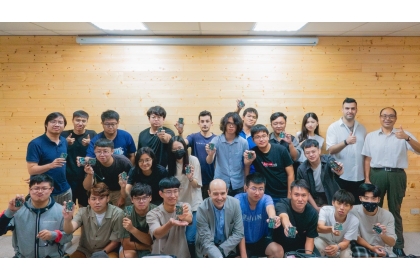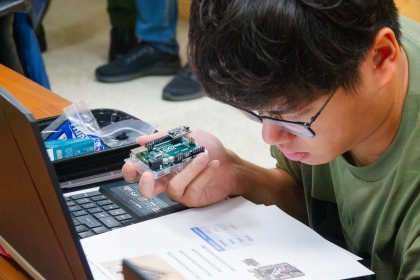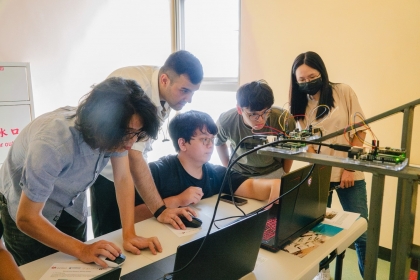National Chung Hsing University and College of Engineering collaborates with The University of New Mexico and Fulbright Hays Faculty Research Abroad with STEM Education
2023-08-25
興新聞張貼者
Unit秘書室
2,863
Source:NCHU College of Engineering
This August 18th the College of Engineering hosted the first Low-Cost Efficient Wireless Intelligent Sensor (LEWIS) Workshop in Structural Health Monitoring at Taichung, in collaboration with the University of New Mexico (UNM), the Fulbright Foundation of US and Taiwan. The college of engineering is known for its STEM excellence, as they have multiple educational activities that focus on new technologies in the classroom. However, the training in new technologies in engineering is in general below the expectations on industry as there are no regular classes on these advance technical contents, and hence no time to teach new materials in the curriculum. Historically, this has caused a mismatch between demands from jobs on new technologies and the sensor technology. Professor Moreu from UNM and the professors Song and Chi-Chin at NCHU have created a workshop in sensing technology to bridge that gap. Assistant Professor Shieh-Kung Huang also assisted the workshop and encouraged students to learn the new LEWIS approach to structural health monitoring.
The 22 engineering students attended a workshop hosted by the College of Engineering. The class is part of the collaboration of Professor Moreu with Taiwan Universities and the Smart Management of Infrastructure Laboratory (SMILab) at UNM, and other Universities including National Taiwan University, Taiwan Tech, Kaohsiung University, and Keelung University.
This workshop helps to integrate STEM into practical learning for engineering students looking to be prepared for the challenges of the next centuries on digital twin and machine learning. The sensor used in this workshop is the Low-Cost Efficient Wireless Intelligent Sensor (LEWIS), state-of-the-art technology made by SMILab. These LEWIS sensors allow accurate measurements of an object's position over time, while using affordable equipment within a simplistic design (more information).
The 22 students worked for three hours under the supervision from mentors from NTU (Yi-Cheng Li and Mojtaba Fathisepahvand) and NCHU (Meng-Hsuan Tsai and Chih-Hsiang Chang), as well as NCHU faculty and staff that organized the event during the summer. The objective of this workshop from the faculty and staff perspective is to attract talent to the engineering workforce with new technologies that are available today such as drones, sensors, Augmented Reality, and 3D printing. The students also communicated with students colleagues at the US, like Morgan, a freshman in civil engineering who connected remotely to join and assist the workshop. It was a great international experience for the students involved, and the mentors. The faculty praised the help of the staff who made it possible, and the preparation of the mentors to assist the students taking the workshop.
Moreu emphasized the utility of these sensors for education. “In general, our college students in engineering are familiar with software or computer games, but they are not trained to fabricate things. If they fabricate a simple sensor with their hands, themselves, they become brave to learn things that they thought were impossible. It’s like a superhero when they discover their powers.”
SMILab has used LEWIS in different environments, you can click here to see a train turned into a sensor class.
The NCHU side was led by Professor Shin-Tai Song and Tsai Chi-Chin from the Department of Civil Engineering, who have been planning this activity since June, when Professor Moreu visited NCHU. During the last few months, their staff has been working diligently in selecting the sensing technology, Arduino boards, distributors, ordering parts, and preparing the laboratories. The graduate students from National Taiwan University worked together with the graduate students from NCHU to ensure the workshop was a great success. Soldering, testing, and field checks included structural components natural frequencies in the science and technology building at NCHU and the earthquake shaking table that replicated motions that were measured using LEWIS. The entire group of students and mentors completed a survey where they indicated their interest for more international activities in which US and Taiwan can advance new technologies.
Dean Ming-Der Yang, also a civil engineering faculty, opened the event welcoming the international collaboration and promoting more opportunities with collaborations at the College of Engineering level with UNM, since the chair of Mechanical Engineering is also collaborating with NCHU and visited the campus last month. The future interactions between UNM and NCHU will include both undergraduate and graduate students exchanges, faculty exchanges for teaching courses, summer schools, and other activities such as internships.
The pictures below show a summary of the activities of the first LEWIS Workshop. Looking forward to more student-centered activities advancing new technologies and experiences for the engineers of the future.
This August 18th the College of Engineering hosted the first Low-Cost Efficient Wireless Intelligent Sensor (LEWIS) Workshop in Structural Health Monitoring at Taichung, in collaboration with the University of New Mexico (UNM), the Fulbright Foundation of US and Taiwan. The college of engineering is known for its STEM excellence, as they have multiple educational activities that focus on new technologies in the classroom. However, the training in new technologies in engineering is in general below the expectations on industry as there are no regular classes on these advance technical contents, and hence no time to teach new materials in the curriculum. Historically, this has caused a mismatch between demands from jobs on new technologies and the sensor technology. Professor Moreu from UNM and the professors Song and Chi-Chin at NCHU have created a workshop in sensing technology to bridge that gap. Assistant Professor Shieh-Kung Huang also assisted the workshop and encouraged students to learn the new LEWIS approach to structural health monitoring.
The 22 engineering students attended a workshop hosted by the College of Engineering. The class is part of the collaboration of Professor Moreu with Taiwan Universities and the Smart Management of Infrastructure Laboratory (SMILab) at UNM, and other Universities including National Taiwan University, Taiwan Tech, Kaohsiung University, and Keelung University.
This workshop helps to integrate STEM into practical learning for engineering students looking to be prepared for the challenges of the next centuries on digital twin and machine learning. The sensor used in this workshop is the Low-Cost Efficient Wireless Intelligent Sensor (LEWIS), state-of-the-art technology made by SMILab. These LEWIS sensors allow accurate measurements of an object's position over time, while using affordable equipment within a simplistic design (more information).
The 22 students worked for three hours under the supervision from mentors from NTU (Yi-Cheng Li and Mojtaba Fathisepahvand) and NCHU (Meng-Hsuan Tsai and Chih-Hsiang Chang), as well as NCHU faculty and staff that organized the event during the summer. The objective of this workshop from the faculty and staff perspective is to attract talent to the engineering workforce with new technologies that are available today such as drones, sensors, Augmented Reality, and 3D printing. The students also communicated with students colleagues at the US, like Morgan, a freshman in civil engineering who connected remotely to join and assist the workshop. It was a great international experience for the students involved, and the mentors. The faculty praised the help of the staff who made it possible, and the preparation of the mentors to assist the students taking the workshop.
Moreu emphasized the utility of these sensors for education. “In general, our college students in engineering are familiar with software or computer games, but they are not trained to fabricate things. If they fabricate a simple sensor with their hands, themselves, they become brave to learn things that they thought were impossible. It’s like a superhero when they discover their powers.”
SMILab has used LEWIS in different environments, you can click here to see a train turned into a sensor class.
The NCHU side was led by Professor Shin-Tai Song and Tsai Chi-Chin from the Department of Civil Engineering, who have been planning this activity since June, when Professor Moreu visited NCHU. During the last few months, their staff has been working diligently in selecting the sensing technology, Arduino boards, distributors, ordering parts, and preparing the laboratories. The graduate students from National Taiwan University worked together with the graduate students from NCHU to ensure the workshop was a great success. Soldering, testing, and field checks included structural components natural frequencies in the science and technology building at NCHU and the earthquake shaking table that replicated motions that were measured using LEWIS. The entire group of students and mentors completed a survey where they indicated their interest for more international activities in which US and Taiwan can advance new technologies.
Dean Ming-Der Yang, also a civil engineering faculty, opened the event welcoming the international collaboration and promoting more opportunities with collaborations at the College of Engineering level with UNM, since the chair of Mechanical Engineering is also collaborating with NCHU and visited the campus last month. The future interactions between UNM and NCHU will include both undergraduate and graduate students exchanges, faculty exchanges for teaching courses, summer schools, and other activities such as internships.
The pictures below show a summary of the activities of the first LEWIS Workshop. Looking forward to more student-centered activities advancing new technologies and experiences for the engineers of the future.




